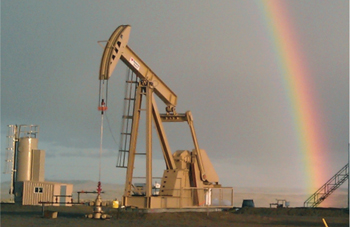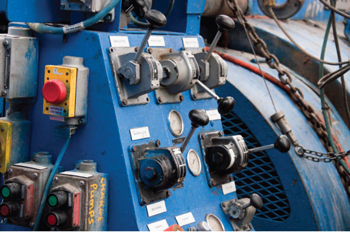
Banking On Tight Oil: The Risk Worth Taking
By Al Pickett, Special Correspondent
As the unconventional becomes the industry norm rather than the exception, a growing number of independents–both large and small–are betting their futures on tight oil plays. Although horizontal drilling and giant multistage fracturing increases well costs in these unconventional tight oil resource plays to the point at which they dwarf those of many conventional vertical wells, many companies are banking on the conviction they can make the tight oil source rocks economical. In many instances, they are doing so in areas where experts once balked at the possibility of commercial oil development.
So what do companies look for as they map strategies for focusing their capital on unconventional tight oil plays?
“We try to position ourselves in a petroleum system, a basin or fairway that has had substantial oil production, in pursuing horizontal targets,” responds Peter Dea, president and chief executive officer of Denver-based Cirque Resources. “Once you establish multiple targets for horizontal drilling, you have decades of development drilling.”
Emerald Oil Inc., a Denver-based independent producer, employs a development strategy with a focus on growing exclusively through drilling and producing oil in the Bakken Shale. Emerald President McAndrew Rudisill says the cost of Emerald’s Bakken wells, which average about $11 million, does not detract from its enthusiasm about the play. Even so, the company tends to recover its investment in two years or sooner, Rudisill claims, adding that Emerald has more than 50,000 net Williston Basin acres in North Dakota and Montana that are prospective for oil in the Bakken and Three Forks.
ZaZa Energy Corp., which has offices in Houston and Corpus Christi, Tx., is focused on the Eagle Ford and Eaglebine plays in South Texas. Kevin Schepel, ZaZa’s executive vice president for exploration and production, has spent his career working in tight oil and gas formations, and he expresses the belief that the key for producers hoping to develop unconventional resource plays is to do their homework.
“It is not all about getting the best well right off the bat,” he offers. “Sure, it would be great to get 1,000 barrels a day out of your first well, but that is not always realistic. The important thing is to design a well to get producible hydrocarbons and to get the technical information you need to assess commerciality. It pays off in the end. The first wells are important to prove up the play and drive future expansion and development.”
Three companies, operating in about a half dozen plays, all with different strategies and varying business models, share at least one thing in common: They are betting on tight oil as the main ingredient to their growth.
Dea says Cirque Resources’ business model is to build and sell, which it first did in the Bakken Shale. Now it is following the same template in the Codell/Niobrara play along the Colorado-Wyoming border and the Heath Shale in Central Montana. Cirque establishes a large position based on geology, finds a partner, establishes production and then sells before the major development phase, according to Dea.
With 300,000 gross acres in northern Weld County, Co., and Laramie County, Wy., Cirque Resources LP is developing the Niobrara and Codell Sandstone formations. According to the company, the Denver-Julesburg Basin offers a hybrid play of wet gas and oil in which the Niobrara/Codell system trends increasingly to oil as it progresses north from the Wattenberg Field.
Whether it is the Bakken Shale in the Williston Basin, the Codell/Niobrara in the Denver-Julesburg Basin, the Eagle Ford Shale in South Texas, or the emerging horizontal Wolfcamp, Cline Shale and Bone Spring plays in the Permian Basin, he says companies are finding success in a number of reservoirs that the industry has long ignored.
Dea indicates three questions arise in the context of evaluating and developing a tight oil play: What does the reservoir rock maturity, pressure and trap look like? Is there commercially movable oil? What is the economic viability?
“Even if there are marginal initial wells, can you see a path to commerciality?” Dea asks. “The real efficiency comes as you move into a development mode, in some cases drilling from locations with eight-plus wells a pad.”
He claims it is possible to follow the progression of multiple targets in tight oil plays and cites the initial Bakken development as an example, where the horizontal Sanish/Three Forks then followed three or four years later. “Likewise, the horizontal Niobrara in the D-J Basin was followed by the horizontal Codell Sandstone a year or two later,” Dea adds.
Multiple Pay Zones
The greater Denver Basin, according to Dea, is a perfect example of the multiple pays that Cirque Resources seeks as it develops tight oil plays. Not only are there the Niobrara B and C zones, Cirque also has begun targeting the Codell Sandstone, which he says has been perforated and commingled with the Niobrara historically in the Wattenberg Field’s vertical wells. “You establish one horizontal target, and then you move to another,” he explains. “People are looking for the next Bakken. Once you find it, you are off to the races.”
Dea says Cirque initially establishes a leasehold and then secures a partner. “Cirque usually serves as the operator and brings its partner up the learning curve on horizontal oil resource plays,” he continues. “We and our partner work together to drive the technology and understanding, and learn from each other.”
Cirque has 300,000 gross acres with a 25 percent partner in the Denver-Julesburg Basin, exploiting the Niobrara and Codell Sandstone formations. Dea notes that Cirque’s partner has drilled four horizontal wells in the Niobrara, while Cirque recently drilled its first operated Codell lateral well and is planning several more. Its first operated well in the Codell was the Warren No. 17-1CH.
“It is a huge resource play,” he describes, adding that the Denver and the Powder River basins are divided by a modest Laramide-age uplift, but in reality they were once one large Cretaceous-age basin that has produced more than 3 billion barrels of oil equivalent. The two basins were part of an intercontinental seaway 100 million-70 million years ago, he elaborates, which deposited a significant quantity of organic-rich shale, carbonates, chalks and some sandstones that eventually made for good reservoirs. “The Niobrara chalk resulted from the mixing of warm and cold water that created carbonate-silica rich critters, which accumulated on the sea floor and lithified into rock,” Dea adds.
He says Cirque’s acreage sits right in the middle of that Paleo basin in northern Weld County, Co., and Laramie County, Wy. He points out that the Denver Basin offers “a hybrid (wet gas/oil) play, but as one moves north away from the huge Wattenberg Field, the Niobrara/Codell system has a lower gas-to-oil ratio.”
Paradigm Shift
According to Dea, it constituted an industry “paradigm shift” when Cirque started focusing on horizontal oil drilling in the Rockies, which long had been considered a gas province. “A lot of our industry partners did not think you could get oil by horizontal drilling when we started in 2007,” he says. “Very few were focused on oil resource plays.”
By being ahead of the curve, however, Cirque’s land team leased 1.3 million acres in the various oil resource plays. “Now, you would have a hard time doing that,” he observes. “The Bakken took off, then the Niobrara and the Eagle Ford Shale in Texas–which is the Bakken on steroids. The last few years, the industry has realized we can get oil from horizontal wells. America needs more oil and we can add oil domestically and control our destiny. Five years ago, not many companies had teams designed to get into tight oil plays. Then, two years ago, the majors formed unconventional or tight oil teams. Most companies now have developed expertise in tight oil plays, and there has been a big land grab. That makes it more challenging for small companies to find a niche.”
Dea notes that companies with big land positions are seeking partners to help them drill during the next couple years. Preferring to focus on the more fun and nimble exploration phase, Cirque Resources’ model is designed to build, prove up and sell early, passing the manpower- and capital-intensive multidecade development program to a larger company.
“As you increase activity in each new tight oil play, you reduce costs and increase reserves,” he relates. “Some plays are very economic right off the bat, but in most plays the initial wells cost too much. When you crack the nut and learn how to tweak the wells, costs come down and efficiency goes up. It is remarkable. In the last five years as oil resource plays have evolved, there has been a pretty pronounced increase in initial production and reserves with a reduction in costs each year as companies fine-tune their drilling and completion techniques.”
Dea points out that the progression of the industry’s remarkable efficiency shown in vertical wells now is manifest in horizontal ones. Vertical wells that once took 60 days to drill in Wyoming’s Pinedale Anticline now take 11-14 days. Likewise, he says, early horizontal Niobrara wells that took 22 days to drill a few years ago now take only 9 days.
In addition to its development in the Niobrara, Dea says Cirque also is exploring the Heath Shale, which he describes as “another oil resource play in a proven system.” Historically, that Central Montana region has produced nearly 150 million barrels in the Tyler and Cat Creek sands, mostly sourced from the Heath Shale.
Cirque Resources’ discovery well in the Heath Shale, the Rock Happy 33-3H-2, was drilled in November 2011 and made 271 bbl/d. A few months later, Fidelity E&P drilled the Schmidt 344-27H a mere eight miles away and it averaged 249 bbl/d during its first 25 days.
Dea says Cirque has not drilled in the Heath since its discovery well, but that will change this year. He reports the company has acquired 3-D seismic in four areas to delineate its next suite of drilling locations, which are planned for this year. Cirque also is planning to drill a horizontal well in the Powder River Basin’s Mowry formation.
The picture for new plays will begin to take a more defined shape with time, he reasons. Any new tight oil play, Dea suggests, often requires two-three years of history and multiple wells before producers are sufficiently comfortable that they understand the play’s development potential. “Unlike conventional plays, industry still continues to grossly underestimate the full potential of new resource plays as recovery factors, well density, multiple targets and efficiencies grow over time to add to the significant prize,” Dea concludes.
Well-Capitalized Strategy
One key to Emerald Oil’s growth strategy in the Bakken Shale, indicates company president Rudisill, its strong capital position. The company raised $75 million with a public offering in September, he says. Then in February, Emerald announced that it had signed a definitive agreement with White Deer Energy, an energy private equity firm with offices in Houston and New York, to issue and sell $50 million in perpetual preferred stock to White Deer.
Emerald Oil Inc. says it is focusing its 2013 capital expenditures on the Bakken Shale play, where it holds more than 50,000 net acres. The company indicates its primary target is the Middle Bakken, although some drilling units may make it feasible to pursue other tight oil horizons from the same pad.
Emerald also generates $5 million a quarter in cash flow from its Bakken Shale production, which Rudisill contends will continue to grow. He says his company also has a $27.5 million line of credit at 2.5 percent interest from Wells Fargo. That well-capitalized position will fund Emerald’s Williston Basin plans to spend approximately $100 million in 2013, primarily in McKenzie County, N.D.
“We have one rig running and have announced in our guidance that we will drill 10 operated wells this year,” Rudisill says, “although we may add another rig in the back half of the year. With the availability of rigs and frac equipment, it will be easy for us to add another rig.”
Emerald, which merged with Voyager Oil and Gas last year to convert Voyager’s nonoperated acreage, started acquiring Bakken acreage four years ago and announced average production of 972 boe/d in third quarter 2012.
“We are also still actively seeking more acreage,” Rudisill adds.
He says Emerald’s drilling is focused on the Middle Bakken, but some drilling units will allow it to target the Upper Three Forks and potentially the Lower Three Forks from the same pad, providing further evidence that tight oil plays tend to offer multiple pays.
“The Bakken will provide years of drilling,” Rudisill continues. “There is a lot more oil in place than the market understands.”
Emerald’s Bakken emphasis was reinforced in January, when the company announced it had agreed to sell interests in 30,902 net mineral acres in the Sand Wash Basin to a private oil and gas company for $10 million cash at $325 an acre. Emerald originally held 45,100 net mineral acres in the Sand Wash Basin, but with the sale is divesting about two thirds of its acreage that is mostly in Carbon County, Wy. and Moffat County, Co.
Emerald retained approximately 14,000 net acres surrounding the Focus Ranch Unit in Routt County, Co. The company also has 33,500 net acres in Central Montana, prospective for oil in the Heath Shale formation. Nevertheless, Rudisill states Emerald’s capital expenditures in 2013 will focus exclusively on developing its Bakken Shale acreage.
Understanding Tight Oil
ZaZa Vice President Schepel says he started his career with Exxon in Midland, Tx., mainly doing formation evaluation in tight reservoir rocks, both on- and offshore. He then spent 1998-2008 as vice president of worldwide exploitation with Pioneer Natural Resources, focusing on development drilling in the offshore Gulf of Mexico, Alaska, West Texas and South Texas.
He says Pioneer was expanding its position in the Edwards play when it stumbled onto the Eagle Ford in 2005. He left in 2008 to put the San Isidro Development package together, building a large Eagle Ford position in McMullen County, before it was sold to Chesapeake Energy Corp. and Petrohawk Energy Corp.
Schepel then joined ZaZa, which was established in 2010 to focus on unconventional reservoirs in South Texas. ZaZa formed a partnership with Hess Corp., he says, which wanted to shift focus to the onshore and get involved in the Eagle Ford. The partnership drilled 28 wells in 18 months, focusing on the most economic areas in the core of the Eagle Ford, according to Schepel.
“We focused on drilling proof-of-concept wells armed with conventional core, some of the most advanced logging suites available and custom petrophysics designed through detailed integration of the physical rock and fluid data,” he explains. “Schlumberger tested a number of its new logging tools with us. It was not total science because we were drilling to make productive wells in what we knew was a proven area of the play. The Edwards wells we used for control were traditional vertical acid fracs or laterals shorter than 1,200 feet. They were the key to delineating and evaluating the Eagle Ford potential in (Texas’) McMullen, Live Oak and Dewitt counties.”
As the Eagle Ford exhibited such encouraging shows, Schepel says, Pioneer and other early players realized the shale could be a reservoir. Physical rock properties are also critical to the play, he relates. “ZaZa took more conventional and rotary core samples in the first 18 months than most of the industry had done previously,” he claims. “It confirmed the Eagle Ford was actually 65-70 percent carbonate with high gamma ray because of the uranium associated with the organic kerogens. The play evolved as old Edwards wells were re-evaluated and most of the industry delineated potential fairways with net pay maps of high gamma ray resistivity above 10 ohms. That was its first phase, and since then it has grown from a one-and-a-half county mini-basin to a play that now covers 10 counties. The play’s extension allowed us to expand.”
During that time, Schepel says, ZaZa cooperated with Schlumberger to implement technologies such as alternating two wells’ stimulations off the same pad, and flow-channel hydraulic fracturing, which he says has helped ZaZa’s wells meet expectations for reservoir conductivity and producibility while using less proppant.
In 2012, ZaZa split its assets with Hess, which kept the proven acreage in the heart of the play. The 72,000 acres ZaZa has kept includes the Moulton area on the Eagle Ford’s eastern extension, where the company says it has identified 103 net locations. Since then, the company’s announcements include a report that it has installed an artificial lift system on the Crabb Ranch A-1H well in Gonzales County, Tx. The well, which by late January had been on line for 13 months, was producing 256 boe/d (91 percent oil) and had produced 92,000 bbl.
With the encouraging initial production rates at its Boening A-1 well in DeWitt County, Tx., ZaZa Energy Corp. says it has confirmed characteristics necessary for a low resistivity play that points to a new expansion of the Eagle Ford Shale. Zaza reports its strategy enjoyed similar success in 2010, when it partnered on drilling proof-of-concept wells in the Eagle Ford’s core areas.
As it did in the Barnett Shale, Schepel points out, the industry initially targeted dry gas and gas condensate in the Eagle Ford, but the play has expanded and changed with the lure of liquids. “The Eagle Ford is now more of an oil play,” he continues. “When Petrohawk started, it was mostly gas in an expanded Eagle Ford section below the Edwards Shelf Margin.”
ZaZa also began 2013 with high hopes for the company’s Boening A-1 well in its Sweet Home development in DeWitt County. In addition to its appraisal of the Moulton and Sweet Home areas, Schepel notes ZaZa also has its Hackberry operations to the east, in which a couple of deeper wells have yielded liquid shows, as well as the Oakland area. Before the Boening well’s results were in, he said its results would greatly influence the outlook for the additional areas.
“If the Boening works, it opens a whole new expansion,” he said in late January. “This well is the first test of the low resistivity organic Eagle Ford, which is similar in composition to the Eaglebine in East Texas.”
A couple weeks later, ZaZa announced initial production rates from the Boening A-1, said it provided the proof of concept for the low resistivity play, and therefore opened it to Schepel’s aforementioned new expansion. Under controlled flow back, the well achieved initial production rates of 669 boe/d, or specifically, 264 bbl/d and 2.4 MMcf/d of natural gas on a 12/64-inch choke. From a four point test analysis, Zaza says it calculated an absolute open flow rate of 1,020 boe/d, or 420 bbl/d and 3.6 MMcf/d.
The Eagle Ford is broken into upper and lower zones, with the upper section offering a chalky component, Schepel elaborates. “This expanded interval allows us to use staggered laterals to increase well density, with a lateral in one section and another lateral deeper in the section as you down space,” he explains.
Eaglebine
As ZaZa stepped out to the east, it also focused on the siliciclastic shales of the Houston Salt Basin, which–as a combination of the Eagle Ford group and Woodbine group–have become known as the Eaglebine. Schepel calls the Eaglebine “toe-of-slope sands from the Woodbine deltas that terminated into the organic rich basinal shales.” He says the Eaglebine is different than the Eagle Ford because of the latter’s greater sand and silt composition. Resistivity is lower because of a decrease in carbonate and the increased conductivity of the fine grained, laminated sands and silts.
According to Schepel, ZaZa owns and operates 88,000 contiguous net acres in the Eaglebine, which is located in a portion of the basin that is highly organic and particularly thick. He adds that the Eaglebine development is separate from its Eagle Ford operations and requires its own level of technical due diligence. “If you think you can apply the same drilling and completion technology in the Eaglebine as in the Eagle Ford, you will fail,” he emphasizes.
Schepel says ZaZa intends to evaluate various development scenarios in the Lower Eaglebine, Upper Eaglebine and Lower Cretaceous sections of its Eaglebine acreage by drilling its initial proof-of-concept wells. ZaZa describes the Eaglebine and Lower Cretaceous as having multiple pays, similar to the Permian Basin’s Wolfberry. “The presence of the laminated sand, silt and shale in the Eaglebine and multiple stacked carbonate pays in the Lower Cretaceous lends itself to both long-reach horizontal and more conventional commingled vertical completion strategies,” Schepel holds.
According to the company, well log results from its initial Eaglebine well, the Stingray A-1H in Walker County, show an estimated 21 Bcf and 29 MMbbl a section in place, or 980,000 boe recoverable, applying an 18-20 percent recovery factor.
After completing hydraulic fracturing operations in the Stingray A-1H, the company says, the casing suffered a collar failure caused by embrittlement. But ZaZa indicates it has prepared the Stingray for re-entry and plans to drill through the Lower Cretaceous, below the Lower Eaglebine, and will attempt to complete it as a vertical commingled well.
ZaZa also announced in late January that its second exploration well in northern Walker County, the Commodore A-1, was drilling ahead at 12,237 feet and had recovered strong mud log shows indicative of liquid hydrocarbons in the Lower Eaglebine and into the Lower Cretaceous. Schepel says the company is evaluating the possibility of making a dual completion in the Lower Eaglebine and commingling the Lower Cretaceous zones.
As he ponders his company’s approach to tackling tight oil plays, Schepel maintains it is important to take risks. “If we all followed the same industry path, we would all make the same maps and compete in the same areas,” he contends. “You have to get out of the box and think ahead of the play. Where does it go? How does it change? It does not always work, but you have to take risks to grow a play. By doing that, it often comes at lower (leasing) cost.”
For other great articles about exploration, drilling, completions and production, subscribe to The American Oil & Gas Reporter and bookmark www.aogr.com.









